child restraint MAZDA MODEL 3 HATCHBACK 2010 (in English) Owner's Guide
[x] Cancel search | Manufacturer: MAZDA, Model Year: 2010, Model line: MODEL 3 HATCHBACK, Model: MAZDA MODEL 3 HATCHBACK 2010Pages: 488, PDF Size: 6.52 MB
Page 55 of 488

Black plate (57,1)
3. Secure the child-restraint system using
BOTH LATCH lower anchors,
following the child-restraint system
manufacturer's instructions. Pull on the
child-restraint to be sure both anchors
are engaged.
4. If your child-restraint system came
equipped with a tether, that means it is
very important to properly secure the
tether for child safety. Please carefully
follow the child-restraint system
manufacturer's instructions when
installing tethers.
Anchor bracket location (4 Door)
Anchor bracket
Tether strap position (4 Door)
Anchor bracket
Tether strap
Anchor bracket position (5 Door)
Tether strap position (5 Door)
Tether
strap
Essential Safety Equipment
Child Restraint
2-43
Mazda3_8AD6-EC-09A_Edition1 Page57
Tuesday, December 2 2008 2:26 PM
Form No.8AD6-EC-09A
Page 56 of 488
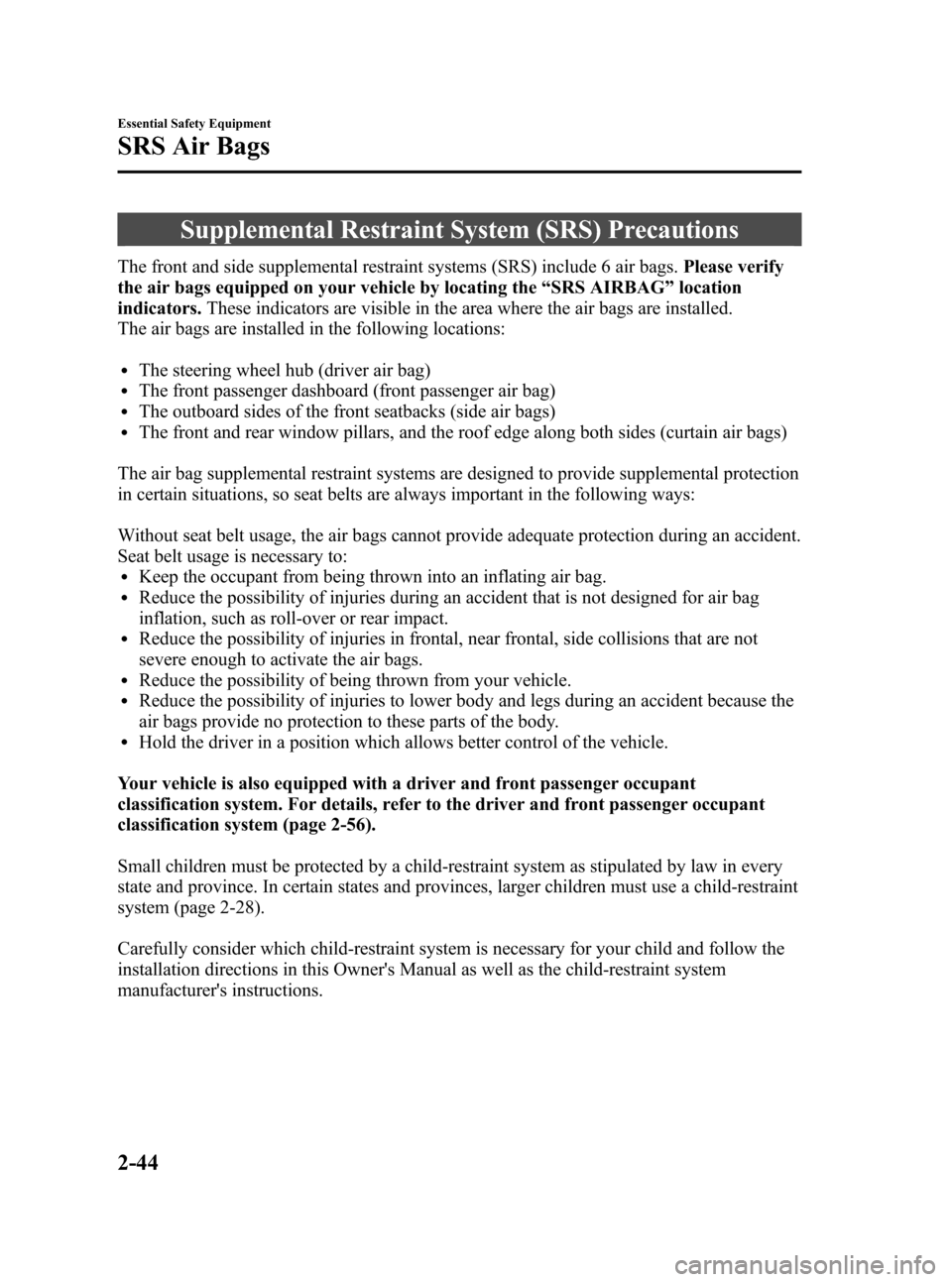
Black plate (58,1)
Supplemental Restraint System (SRS) Precautions
The front and side supplemental restraint systems (SRS) include 6 air bags.Please verify
the air bags equipped on your vehicle by locating the“SRS AIRBAG”location
indicators.These indicators are visible in the area where the air bags are installed.
The air bags are installed in the following locations:
lThe steering wheel hub (driver air bag)lThe front passenger dashboard (front passenger air bag)lThe outboard sides of the front seatbacks (side air bags)lThe front and rear window pillars, and the roof edge along both sides (curtain air bags)
The air bag supplemental restraint systems are designed to provide supplemental protection
in certain situations, so seat belts are always important in the following ways:
Without seat belt usage, the air bags cannot provide adequate protection during an accident.
Seat belt usage is necessary to:
lKeep the occupant from being thrown into an inflating air bag.lReduce the possibility of injuries during an accident that is not designed for air bag
inflation, such as roll-over or rear impact.
lReduce the possibility of injuries in frontal, near frontal, side collisions that are not
severe enough to activate the air bags.
lReduce the possibility of being thrown from your vehicle.lReduce the possibility of injuries to lower body and legs during an accident because the
air bags provide no protection to these parts of the body.
lHold the driver in a position which allows better control of the vehicle.
Your vehicle is also equipped with a driver and front passenger occupant
classification system. For details, refer to the driver and front passenger occupant
classification system (page 2-56).
Small children must be protected by a child-restraint system as stipulated by law in every
state and province. In certain states and provinces, larger children must use a child-restraint
system (page 2-28).
Carefully consider which child-restraint system is necessary for your child and follow the
installation directions in this Owner's Manual as well as the child-restraint system
manufacturer's instructions.
2-44
Essential Safety Equipment
SRS Air Bags
Mazda3_8AD6-EC-09A_Edition1 Page58
Tuesday, December 2 2008 2:26 PM
Form No.8AD6-EC-09A
Page 57 of 488
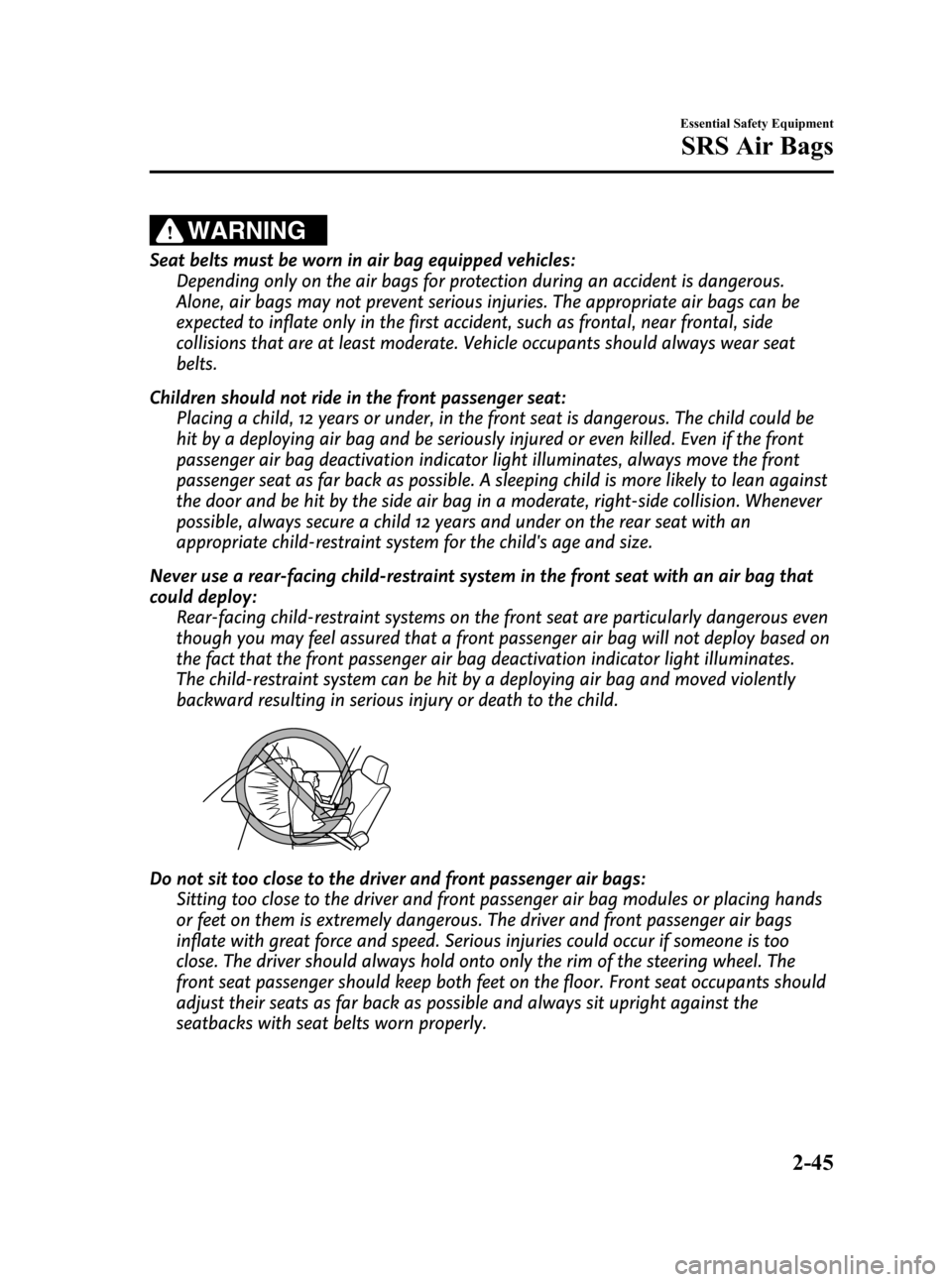
Black plate (59,1)
WARNING
Seat belts must be worn in air bag equipped vehicles:
Depending only on the air bags for protection during an accident is dangerous.
Alone, air bags may not prevent serious injuries. The appropriate air bags can be
expected to inflate only in the first accident, such as frontal, near frontal, side
collisions that are at least moderate. Vehicle occupants should always wear seat
belts.
Children should not ride in the front passenger seat:
Placing a child, 12 years or under, in the front seat is dangerous. The child could be
hit by a deploying air bag and be seriously injured or even killed. Even if the front
passenger air bag deactivation indicator light illuminates, always move the front
passenger seat as far back as possible. A sleeping child is more likely to lean against
the door and be hit by the side air bag in a moderate, right-side collision. Whenever
possible, always secure a child 12 years and under on the rear seat with an
appropriate child-restraint system for the child's age and size.
Never use a rear-facing child-restraint system in the front seat with an air bag that
could deploy:
Rear-facing child-restraint systems on the front seat are particularly dangerous even
though you may feel assured that a front passenger air bag will not deploy based on
the fact that the front passenger air bag deactivation indicator light illuminates.
The child-restraint system can be hit by a deploying air bag and moved violently
backward resulting in serious injury or death to the child.
Do not sit too close to the driver and front passenger air bags:
Sitting too close to the driver and front passenger air bag modules or placing hands
or feet on them is extremely dangerous. The driver and front passenger air bags
inflate with great force and speed. Serious injuries could occur if someone is too
close. The driver should always hold onto only the rim of the steering wheel. The
front seat passenger should keep both feet on the floor. Front seat occupants should
adjust their seats as far back as possible and always sit upright against the
seatbacks with seat belts worn properly.
Essential Safety Equipment
SRS Air Bags
2-45
Mazda3_8AD6-EC-09A_Edition1 Page59
Tuesday, December 2 2008 2:26 PM
Form No.8AD6-EC-09A
Page 71 of 488
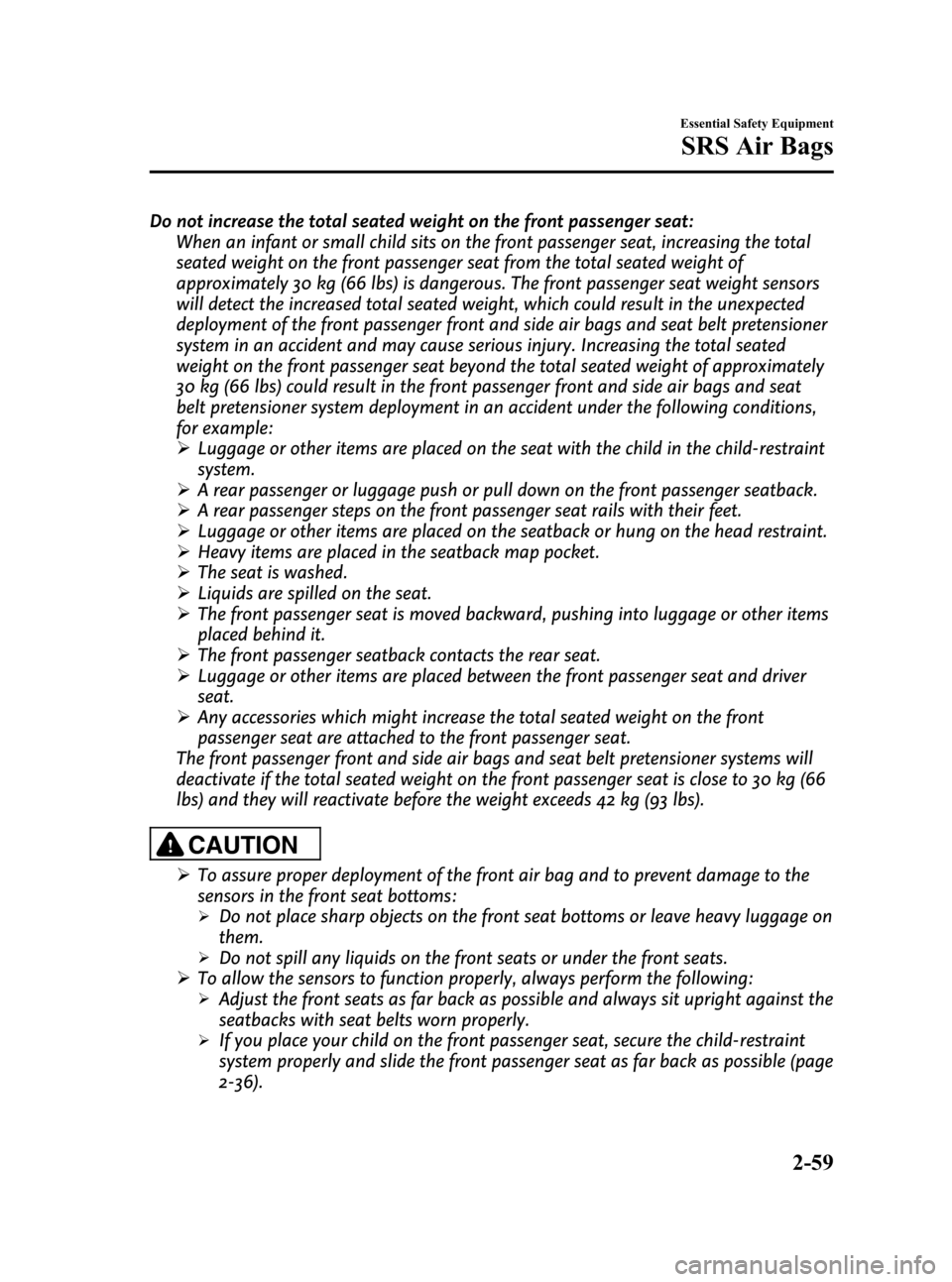
Black plate (73,1)
Do not increase the total seated weight on the front passenger seat:
When an infant or small child sits on the front passenger seat, increasing the total
seated weight on the front passenger seat from the total seated weight of
approximately 30 kg (66 lbs) is dangerous. The front passenger seat weight sensors
will detect the increased total seated weight, which could result in the unexpected
deployment of the front passenger front and side air bags and seat belt pretensioner
system in an accident and may cause serious injury. Increasing the total seated
weight on the front passenger seat beyond the total seated weight of approximately
30 kg (66 lbs) could result in the front passenger front and side air bags and seat
belt pretensioner system deployment in an accident under the following conditions,
for example:
ØLuggage or other items are placed on the seat with the child in the child-restraint
system.
ØA rear passenger or luggage push or pull down on the front passenger seatback.
ØA rear passenger steps on the front passenger seat rails with their feet.
ØLuggage or other items are placed on the seatback or hung on the head restraint.
ØHeavy items are placed in the seatback map pocket.
ØThe seat is washed.
ØLiquids are spilled on the seat.
ØThe front passenger seat is moved backward, pushing into luggage or other items
placed behind it.
ØThe front passenger seatback contacts the rear seat.
ØLuggage or other items are placed between the front passenger seat and driver
seat.
ØAny accessories which might increase the total seated weight on the front
passenger seat are attached to the front passenger seat.
The front passenger front and side air bags and seat belt pretensioner systems will
deactivate if the total seated weight on the front passenger seat is close to 30 kg (66
lbs) and they will reactivate before the weight exceeds 42 kg (93 lbs).
CAUTION
ØTo assure proper deployment of the front air bag and to prevent damage to the
sensors in the front seat bottoms:
ØDo not place sharp objects on the front seat bottoms or leave heavy luggage on
them.
ØDo not spill any liquids on the front seats or under the front seats.
ØTo allow the sensors to function properly, always perform the following:
ØAdjust the front seats as far back as possible and always sit upright against the
seatbacks with seat belts worn properly.
ØIf you place your child on the front passenger seat, secure the child-restraint
system properly and slide the front passenger seat as far back as possible (page
2-36).
Essential Safety Equipment
SRS Air Bags
2-59
Mazda3_8AD6-EC-09A_Edition1 Page73
Tuesday, December 2 2008 2:26 PM
Form No.8AD6-EC-09A
Page 72 of 488
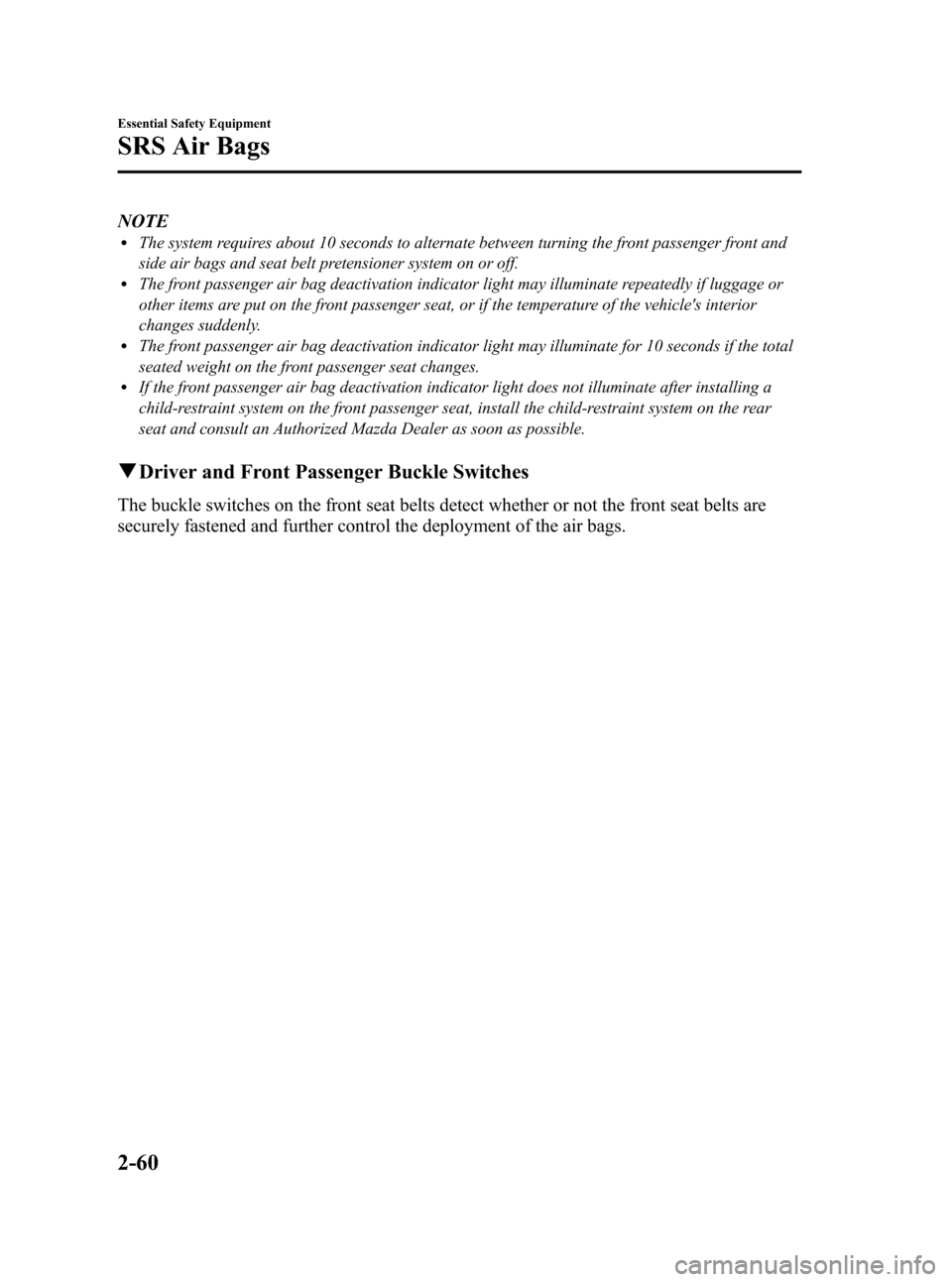
Black plate (74,1)
NOTElThe system requires about 10 seconds to alternate between turning the front passenger front and
side air bags and seat belt pretensioner system on or off.
lThe front passenger air bag deactivation indicator light may illuminate repeatedly if luggage or
other items are put on the front passenger seat, or if the temperature of the vehicle's interior
changes suddenly.
lThe front passenger air bag deactivation indicator light may illuminate for 10 seconds if the total
seated weight on the front passenger seat changes.
lIf the front passenger air bag deactivation indicator light does not illuminate after installing a
child-restraint system on the front passenger seat, install the child-restraint system on the rear
seat and consult an Authorized Mazda Dealer as soon as possible.
qDriver and Front Passenger Buckle Switches
The buckle switches on the front seat belts detect whether or not the front seat belts are
securely fastened and further control the deployment of the air bags.
2-60
Essential Safety Equipment
SRS Air Bags
Mazda3_8AD6-EC-09A_Edition1 Page74
Tuesday, December 2 2008 2:26 PM
Form No.8AD6-EC-09A
Page 483 of 488
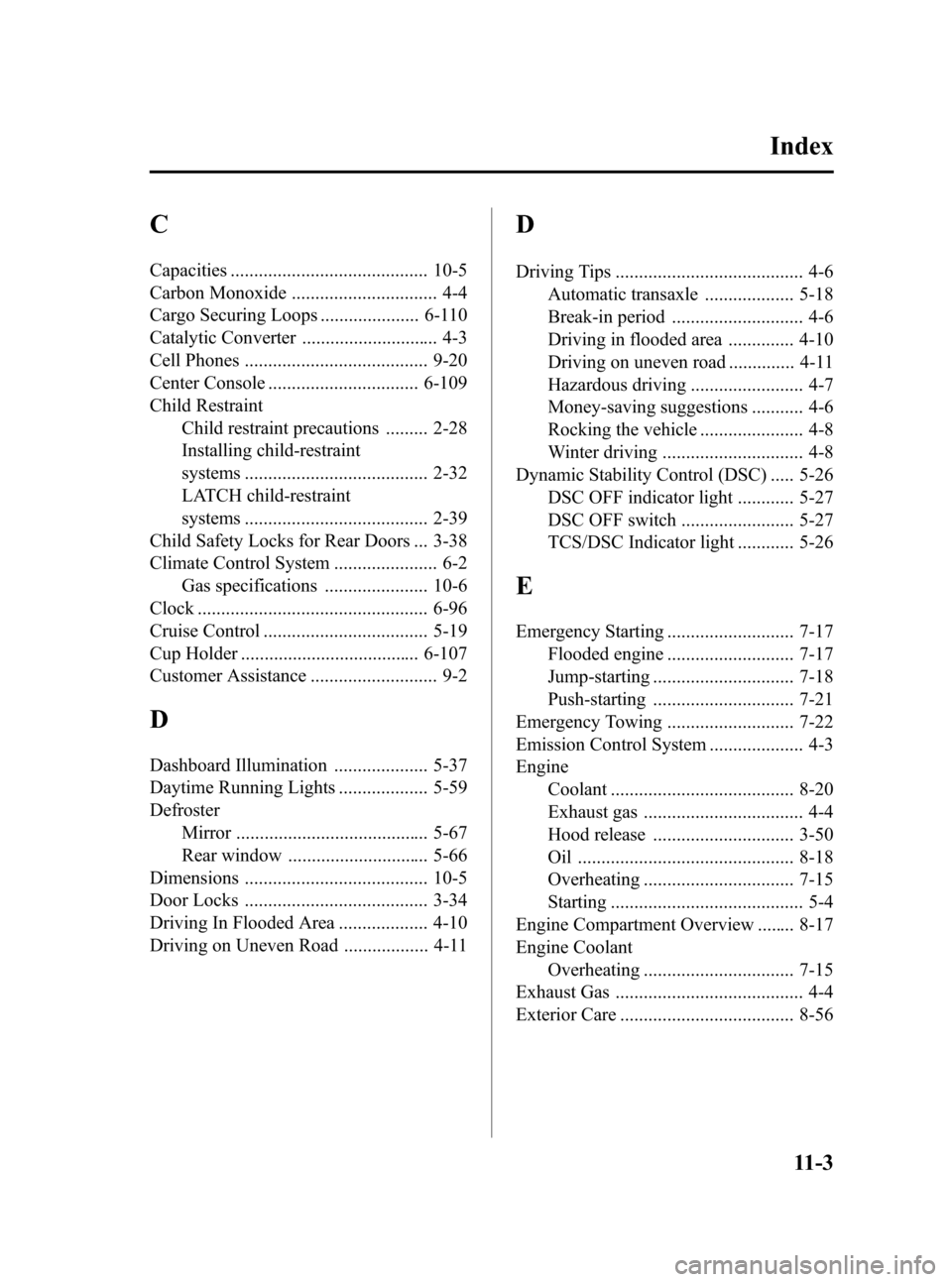
Black plate (485,1)
C
Capacities .......................................... 10-5
Carbon Monoxide ............................... 4-4
Cargo Securing Loops ..................... 6-110
Catalytic Converter ............................. 4-3
Cell Phones ....................................... 9-20
Center Console ................................ 6-109
Child Restraint
Child restraint precautions ......... 2-28
Installing child-restraint
systems ....................................... 2-32
LATCH child-restraint
systems ....................................... 2-39
Child Safety Locks for Rear Doors ... 3-38
Climate Control System ...................... 6-2
Gas specifications ...................... 10-6
Clock ................................................. 6-96
Cruise Control ................................... 5-19
Cup Holder ...................................... 6-107
Customer Assistance ........................... 9-2
D
Dashboard Illumination .................... 5-37
Daytime Running Lights ................... 5-59
Defroster
Mirror ......................................... 5-67
Rear window .............................. 5-66
Dimensions ....................................... 10-5
Door Locks ....................................... 3-34
Driving In Flooded Area ................... 4-10
Driving on Uneven Road .................. 4-11
D
Driving Tips ........................................ 4-6
Automatic transaxle ................... 5-18
Break-in period ............................ 4-6
Driving in flooded area .............. 4-10
Driving on uneven road .............. 4-11
Hazardous driving ........................ 4-7
Money-saving suggestions ........... 4-6
Rocking the vehicle ...................... 4-8
Winter driving .............................. 4-8
Dynamic Stability Control (DSC) ..... 5-26
DSC OFF indicator light ............ 5-27
DSC OFF switch ........................ 5-27
TCS/DSC Indicator light ............ 5-26
E
Emergency Starting ........................... 7-17
Flooded engine ........................... 7-17
Jump-starting .............................. 7-18
Push-starting .............................. 7-21
Emergency Towing ........................... 7-22
Emission Control System .................... 4-3
Engine
Coolant ....................................... 8-20
Exhaust gas .................................. 4-4
Hood release .............................. 3-50
Oil .............................................. 8-18
Overheating ................................ 7-15
Starting ......................................... 5-4
Engine Compartment Overview ........ 8-17
Engine Coolant
Overheating ................................ 7-15
Exhaust Gas ........................................ 4-4
Exterior Care ..................................... 8-56
Index
11-3
Mazda3_8AD6-EC-09A_Edition1 Page485
Tuesday, December 2 2008 2:29 PM
Form No.8AD6-EC-09A